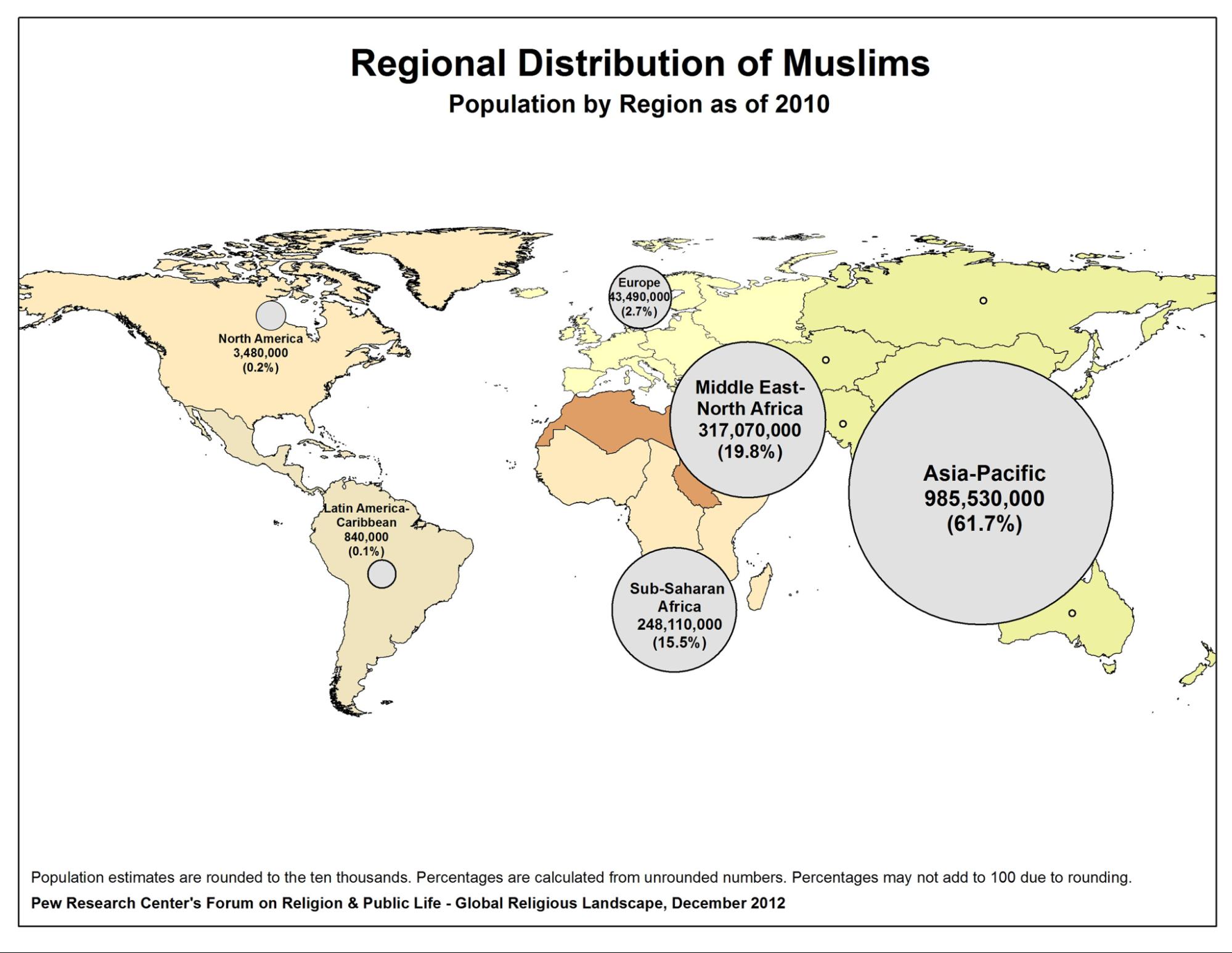Where do Muslims live?
According to data from 2010, the vast majority of Muslims live in the Asia-Pacific region. Pew Research reports 986,420,00 Muslims in the area, compared to 317,070,000 in the Middle East and North Africa, 248,420,000 in Sub-Saharan Africa, 43,470,000 in Europe, 3,480,000 in North America, and 840,000 in Latin-America and the Caribbean.
This means that about 62% of Muslims are in the Asia-Pacific region. The country with the largest number of Muslims is Indonesia, with about 209 million. Only 0.2% of the world’s Muslims live in North America.
Given that most Muslims are not Arab, what is the reason for the deep association between the Arab world and Islam?
Islam originated in the Arab world, specifically in what is now Saudi Arabia in the seventh century CE. It spread from there to other countries, through a combination of trade, traveling Sufi preachers, and military expansionism.
The most important Muslim holy texts are written in Arabic, so many believers choose to learn the language regardless of their ethnic origins.
Additionally, the Middle East and North Africa have the highest concentration of Muslims anywhere; about 93 percent of people in the region are Muslim.
What are the demographics of Muslims in America?
There is no single ethnic or racial group that makes up the majority of Muslim American adults. Pew Research Center considers a plurality of American Muslims, 41 percent, to be white, but that category includes Arabs, Iranians and North Africans, many of whom have lobbied for a different racial and ethnic group categorization on the U.S. census, but that’s another issue! By more precise breakdowns, approximately one third of the community is African-American, one third is of South Asian descent, one quarter is of Arab descent, and the rest are from all over the world, including a growing Latino Muslim population (around 8%). The plurality of Muslim American adults were born in the United States (42 percent). Unsurprisingly the second most common birthplace was South Asia (20 percent), followed by the Middle East/North Africa (14 percent), the rest of Asia (13 percent), Sub-Saharan Africa (5 percent), Europe (2 percent), America outside the U.S. (2 percent), with anywhere else accounting for less than 1 percent.
There were about 3.45 million Muslims of all ages living in the U.S. in 2017, and that Muslims made up about 1.1% of the total U.S. population. That number rose from 0.9% in 2010. Pew Research Center projections suggest that the U.S. Muslim population will grow much faster than the country’s Jewish population. By 2040, Muslims will replace Jews as the nation’s second-largest religious group after Christians.
Additional Information
Young Southeast Asian Muslim Women Are More Religious Yet More Progressive, Study Finds
Young Southeast Asian Muslim women defy categorization by expressing both a deeper commitment to their faith and a deeper belief in progressivism than older generations. Their public piety has driven rapid growth in markets such as the modest fashion and halal food industries.
On Persian pilgrimages, Pakistanis and Indians reconnect with Iran
Islam is said to have originally entered South Asia through Iran. Modern-day pilgrimages by Pakistanis and Indians to saints’ tombs in Iran keep this shared history alive. In South Asia, the reverence for saints frequently overcomes the Sunni-Shia divide, with Sunnis traveling to see the final resting places of Shia imams.
African Muslim in Early America
The first Muslims to come to America were brought involuntarily as part of the transatlantic slave trade more than 400 years ago. Muslim slaves helped build the foundation of America. Although they were pressured to give up their faith, many continued to practice in secret; for example, they wrote out Muslim prayers in Arabic, but labeled them with them as psalms and bible verses to disguise their true nature from those around them. Some aspects of the enslaved Muslims’ faith continued to survive in African American culture, such as singing in the style of the adhan and dancing in a manner that reference the circumambulation of the Kaabah.
The Americanization of an Ancient Faith
The Coptic Church in the United States is trying something new. Can this 2000-year-old Egyptian religion adapt to be accessible to Americans with no Egyptian ancestry? Will the Americanization change the faith beyond recognition? The novel project sparks both excitement and trepidation.
For Jewish Israelis of Yemenite Heritage, Reviving a Past
Israelis with Yemenite ancestry are trying to revive their ancient cultural traditions by bringing back practices such as pre-wedding henna parties. The elaborate outfits and beliefs are part of a culture shared by Muslim and Jewish Yemenis.
What is the truth about American Muslims?
This publication, produced by the Interfaith Alliance and Religious Freedom Project of the First Amendment Center, provides answers to frequently asked questions about religious freedom and American Muslims.


